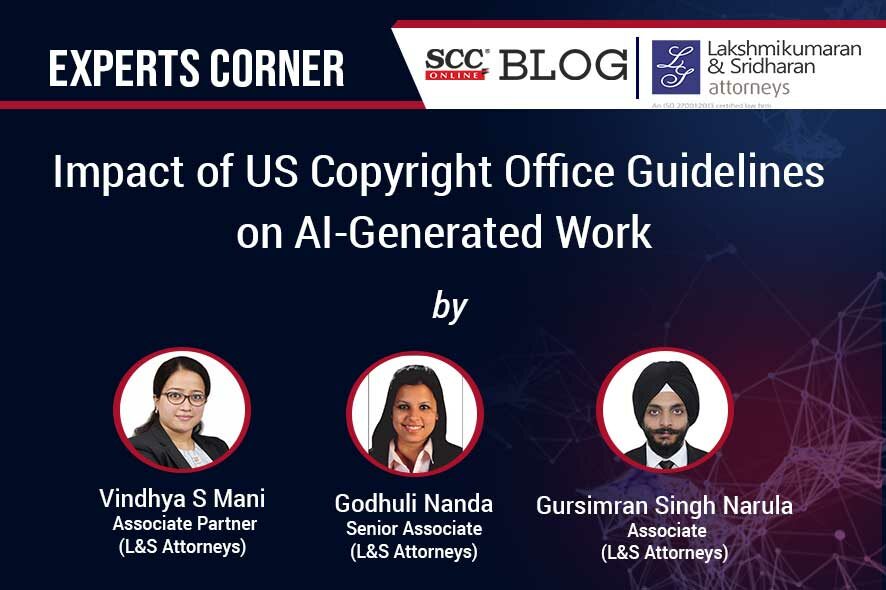The arrival of artificial intelligence (AI) in every aspect of human life is likely to lead to widespread transformation. The ripples of this change can also be seen in the field of law. The advent of sophisticated AI machines, which are creating work that is indistinguishable from human-generated content are challenging conventional norms of human authorship. Traditionally, the courts in the US have recognised human beings as sole authors for copyrighted work and have denied any authorship to non-humans1. However, currently AI is becoming an integral part of almost every creative process and therefore, clarity is required with regard to the scope of copyright protection in works involving AI-generated materials.
Recently, the US Copyright Office (USCO) released a statement of policy, dated 16-3-20232, regarding copyright registration guidance for work containing AI-generated materials. USCO recognised that the work containing material generated by AI may be eligible for copyright protection, but the work shall involve sufficient human authorship. The policy clarifies the USCO’s approach for determining the authorship. USCO would first determine “whether the ‘work’” was of human authorship with mere assistance from an AI machine or whether the authorship of the work was conceived and executed primarily by the machine.
As per the policy, the determination of whether the role of AI was limited to “mechanical reproduction” or extends to “original conception and execution” would be done on a case-to-case basis. USCO, through several illustrative examples, attempted to clarify the examination process. For instance, if an AI machine solely acts when prompted by a human being and it produces a complex work in response to the same, the “traditional elements of authorship” would be considered to have been executed by the machine. In such circumstances, the work generated would not be eligible for copyright protection since such a work lacks ultimate control by humans.
Nevertheless, in another instance whereby humans select or arrange AI-generated material in a sufficiently creative way, the resultant work as a whole can be considered to involve human authorship. Also, copyright protection may be granted if humans modify AI-generated work, and the modifications meet the standard for copyright protection. In such circumstances, copyright protection may be granted only to human-authored aspects. Based on the policy, USCO has advised individuals who use AI technology in their creating process, to claim copyright protection only for the human contribution to that work. Further, the applicants are required to identify the “author created” work and describe the contribution of AI machine separately to facilitate examination by USCO. The policy makes it clear that under no circumstances the AI technology or the AI technology provider be named as the co-author in the application before the USCO.
The USCO’s “statement of policy” for work involving materials generated by AI is a moment outstep in the global debate concerning recognition of AI as an author for copyrighted works. However, the said policy still does not address the basis to determine the exact amount of human involvement required in AI generative work to be eligible for copyright protection.
In India, Section 2(d)(vi) of the Copyright Act, 1957 provides authorship rights only to “person” who causes the computer-generated work to be created. Interestingly, the Rajya Sabha in its 161st Report titled “Review of the Intellectual Property Rights Regime in India” dated 23-7-20213 recognised that the existing Copyright Act is not equipped to facilitate authorship and ownership by AI and has recommended a review of the statute on priority basis. It will be interesting to see the enforcement of this policy by the USCO to determine the exact scope of copyright protection in AI generative work and its implications across the world, including India.
† Associate Partner, Lakshmikumaran and Sridharan.
†† Senior Associate, Lakshmikumaran and Sridharan
††† Associate, Lakshmikumaran and Sridharan
1. Burrow-Giles Lithographic Co. v. Sarony, 1984 SCC OnLine US SC 113 : 28 L Ed 349 : 111 US 53 (1884).
2. “Copyright Registration Guidance: Works Containing Material Generated by Artificial Intelligence, 37 CFR Part 202, Federal Register, Vol. 88, 51, 16-3-2023.
3. Review of the Intellectual Property Rights Regime in India, 161st Report, Department Related Parliamentary Standing Committee Report on Commerce, Rajya Sabha, Parliament of India, 23-7-2021 <http://www.scconline.com/DocumentLink/cf1bdXP5>.






